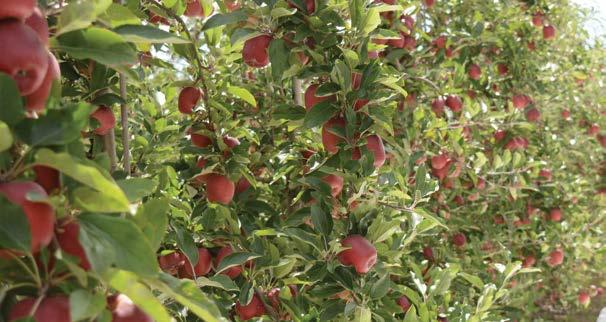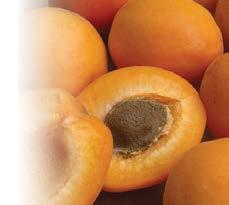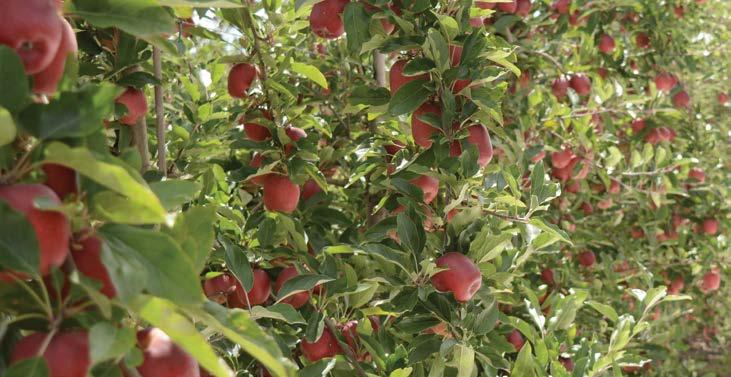
9 minute read
Fertigation in orchard production
A fruiting orchard – in a designed irrigation system, irrigation water is mixed with soluble fertilisers to enhance crop production
When it comes to orchard production, fertilisation and irrigation are the two most important management factors. With advances in technology, fertigation, a technique used to apply fertilisers to plants via irrigation was developed. In a designed irrigation system, irrigation water is mixed with soluble fertilisers to enhance crop production.
By Joachim Nachmansohn
It is an effective and flexible method as it enables the placement and timing of the nutrient application to be controlled. The appropriate nutrients can be applied in relation to the fertility status of the soil as well as the growth stage of the crops. This has been made more effective by using specialty fertilisers and biostimulants. Specialty fertilisers are water-soluble solid fertilisers that release nutrients gradually to plants over a certain period while minimising the possibility of nutrient loss.
These are then complemented with slow or control release products, stabilised, customised, fortified, and liquid or chelated fertilisers (organically enhanced nutrients for optimised uptake). Biostimulants are used in fertigation as activators to enhance the uptake and efficiency of nutrients by plants, but are not nutrients themselves. Think of them as catalysts in a reaction process; in most cases, they are microorganisms or extracts of organic materials such as seaweeds or humic substances (organic compounds). They are used to stimulate the natural processes that benefit the crop such as tolerance to stress and improved crop yield and quality. Humic acids, seaweed extracts like kelp and beneficial bacteria and fungi are a few examples of popular biostimulants. This article focuses on how using fertigation with specialty fertilisers and biostimulants is key in modernising orchard production.
Water requirement
Crop water use efficiency

Flowering, fruit set, fruiting
Days after planting
Figure 1 This illustrates water requirement by the crop over the season. The demand changes with the stage of growth. This illustration is helpful in understanding the concept of optimised irrigation scheduling
Fertigation technology Irrigation has been in use from as early as the 1940s. Wild flooding, furrow and border dyke systems were then used to irrigate fields. With the advent of modern technology these systems have evolved. Currently, sprinkler, drip irrigation and pivot irrigation systems are being used to irrigate and fertilise fields according to the needs of crops (Figure 1 ). Every 12 years, irrigated farmlands have doubled in size in New Zealand, meaning more people are taking up irrigation. Areas around the East Coast and Central Otago receive little rainfall during summer, and irrigation is the only way to enable continuity in production.
Over the years, fertigation has proved its effectiveness in irrigation systems for orchard production. It is considered by environmental enthusiasts as a good form of environmental conservation. It has been found to be very effective in the production of tree crops like avocados, but also in vine crops such as kiwifruit and grapes, and for blackcurrants, while saving on labour costs and improving orchard productivity. About 7% of land in New Zealand is irrigated, and this forms a good foundation for people to take up fertigation. Currently, most fertilisers are still being utilised through basal application as planting and top-dressing fertiliser, but this narrative is about to change. Fertigation using efficient irrigation systems is now considered an essential component in orchard production. Before applying specialty fertilisers together with biostimulants to your irrigation, it is advisable to first do a trial over a small area to see if they will make a significant difference by comparing plants under fertigation treatment with the rest of the crop. It is important to define beforehand what you want to assess; whether it be yield, quality or water/nutrient use efficiency.

L.E. Cooke Nurseryman
Ltd
Growers of high quality fruit trees
• Apples • Apricots • Cherries • Nectarines • Peaches • Pears • Plums
Est 1956
L.E. Cooke Nurseryman Ltd Try us first for your fruit tree requirements!
Marty & Kelli Cooke
PH: 06 870 7043 EMAIL: lecooke@xtra.co.nz CELL: 0274 396 205 (Marty)
Nutrient mix in a fertigation system
Master tank
Tank A Nitrogen, Phosphorous, Potassium, Magnesium, Copper, Zinc, Boron, Molybdenum
Tank B
Iron and Calcium
Tank C
Acid

Figure 2 This illustrates how nutrients generally are mixed in a fertigation system. As a rule, phosphates and sulphates should never be mixed with calcium as this can lead to precipitation causing solid deposits in the tank leading to uneven mixture
There is choice about the type of irrigation system to install. The initial costs involved in setting up and maintaining the system should be considered, whether it is sprinklers, drip irrigation or a pivot irrigation system. Use of sprinklers to inject water-soluble fertilisers has been found to be very effective and affordable. With this system, water will be applied through pipes. You will need a pressure tank that is connected to a vent and directed to the main pipe. The fertiliser is injected into the water tank, which will be distributed to crops via irrigation through sprinklers. Uniform distribution of nutrients is guaranteed with this system and a larger portion of the field will be covered. However, its use is dependent on the weather conditions. If it is too windy, consider waiting for a more appropriate time to fertilise the orchard, otherwise there is a risk that nutrient distribution will not be uniform and that fields will be irrigated unnecessarily. With drip irrigation, also known as trickle irrigation, nutrients are delivered through pipes fitted with emitters or drippers and positioned close to the plants. This is considered more precise as it directly emits nutrients to the roots. The major downside is that it can be prone to clogging (blocking of pipes) that leads to a lack of uniform distribution of nutrients (which of course can be countered with accurate measures). Pivot irrigation systems are popular among orchardists. This is commonly known as the water wheel. In this system, the centre pivot will apply nutrients in a mostly circular pattern around central pivot points (although other options exist). With time setting, fertilisers can be applied at a particular time of the day. Just like sprinklers, it is recommended that crops are irrigated when it is less windy, in the early mornings or late afternoons.
Fertigation scheduling and management The main objective of fertigation scheduling is to maximise yield, irrigation, nutrient efficiency and crop quality by applying the exact amount of water and nutrients needed by the crop, or replenishing the soil moisture to the desired level while applying nutrients.
When devising this schedule, three important questions should be considered:
When to irrigate? Defined by the soil moisture content and growth stage.
How much to irrigate?
Defined by the crop moisture content.
How to irrigate? Defined by the irrigation equipment and the layout.
For efficient fertigation management, the goal is to meet the nutritional needs of the crop while minimising nutrient losses. To achieve this, you will need to consider the availability of nutrients in the soil, the nutrient requirements of the crop, and how the nutrient delivered will match the crop’s need for development. The approaches you take will depend on your level of experience. Generally, you can decide to do a rough estimate of the total amount of fertiliser that will be needed by the crop taking into account any changes that might occur in the availability of nutrients. This is called a prescriptive approach. The measure of nutrients and water that will be taken up by the crop will be the estimated amounts that the crop will assimilate by fertigation for its production.
Alternatively, you can decide to use a corrective plan where through fertigation, the nutrient solution is regulated routinely, based on nutrient demand by the crop and depending on the growth stages and nutrient concentration in the soil. This approach is geared towards minimising the risks of nutrient deficiency and toxicity. For a more experienced orchardist, both approaches can be integrated into one system for optimal fruit production. Before mixing your soluble fertilisers, note that some nutrients, (i.e. fertiliser products), are not directly compatible and therefore need to be stored in separate tanks. Mix all the nutrients together except for iron and calcium that need to be mixed separately. It is often necessary to have yet another tank with acid for adjusting the pH (acidity/alkalinity), as illustrated in Figure 2 . Also, remember to have regular maintenance checks on the system to enhance the life span of the equipment as well as to improve water and nutrient use efficiency.
The benefits The benefits of fertigation are many and should be able to convince any orchardist who has not thought of implementing such a system. I will discuss a few pros and cons here. Target fertilisation allows the addition of nutrients at the exact rate that the plants need at particular growth stages. It helps with uniform application and distribution of nutrients across the irrigated area. It provides equal distribution of specialty fertilisers and biostimulants to all plants, and offers full protection of the soil from degradation resulting from excessive and continuous use of solid fertilisers. When specialty fertilisers and biostimulants are used in this system, enhancement of nutrient uptake by fruit crops in the orchard is guaranteed. These products will help improve the soil’s ability by making the nutrients more available for the plants. Despite the numerous benefits that come with fertigation, uneven nutrient distribution can occur. Having blocked emitters or sprinklers as a result of chemical clogging is also possible. This is likely to happen when you have fertilisers rich in nutrients such as magnesium and calcium and with water that is high in bicarbonates. When this happens, the efficiency of the whole system is reduced and must be addressed. Additionally, fertigation systems only allow use of water-soluble fertilisers that will mix quickly and more efficiently in water, and require the use of special equipment that is resistant to corrosion due to chemical reaction. Despite the high initial cost, fertigation systems have proven to be the most advanced trend in fertiliser application. With the ever-increasing world population and the notable increase in the demand of healthy fruits, fertigation will soon become the most sought-after trend in orcharding.
Reaching all levy-paying fruit growers in New Zealand, in print and online.
If it’s fresh produce in New Zealand, we have it covered.
Online
$95 for 11 issues & $12 for one issue
New Zealand resident: NZ$125 (GST inclusive) Australia & Pacific: NZ$210 (airmail delivery) Rest of the World: NZ$220 or US equivalent (airmail)
For information about how to subscribe please visit hortnz.co.nz/news-events-and-media/magazines










